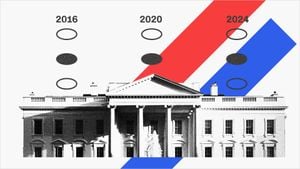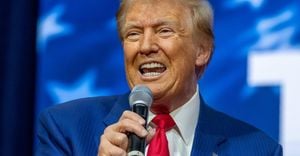Following the recent elections, the U.S. stock market witnessed incredible surge, with the Dow Jones Industrial Average achieving its largest post-election gain since 1896. Investors absorbed not just the ballot results but also the sharp midweek spike in Treasury yields, propelling equities to record highs by Friday. The overarching question was whether this impressive rally would endure, especially with the coming of Donald Trump to the presidency and his party’s control over Congress.
The day after the elections, the stock market reacted positively, aided by expectations surrounding Trump's policies, encompassing potential corporate tax cuts and fiscal reforms which market participants believe could stimulate economic growth. This potential for increased economic activity has inherently raised concerns over inflation, particularly as the labor supply is anticipated to shrink. The market's pulse indicated this worry with Treasury yields indicating the prospects for higher rates coming down the road.
On Wednesday, Treasury yields surged dramatically; the 30-year Treasury saw its largest one-day increase since June 2022. The yield rose 15.3 basis points, reflecting the investor sentiment reacting to Trump's victory and the likelihood of legislative reforms. The 10-year Treasury yield also peaked at four-month highs, translating to higher borrowing costs for businesses and consumers alike.
Despite these developments, stock investors remained buoyant. The juxtaposition of rising yields against record highs for the stock market posed significant intrigue. The Dow gained 1,508.05 points, translating to an impressive 3.6% increase, which underlined the sharp post-election excitement capable of overshadowing financial challenges.
Economists and investors were closely analyzing the potential short and long-term impacts of Trump's anticipated policies. According to Mark Heppenstall, the Chief Investment Officer of Penn Mutual Asset Management, it appears likely the 10-year Treasury yield could reach levels higher than 5% if current trends continued. He emphasized, "My guess is rates in the bond market will keep rising to levels the equity market doesn’t like," signaling anxieties about valuation justifications for equities against the backdrop of rising capital costs.
The early indications post-election revealed broad sentiments across Wall Street. Although the immediate stock market reactions reflected euphoria, the underlying pressures of rising interests loomed large. The heightened Treasury yields are often viewed as unfavorable for equities as they complicate the case for high valuations under traditional market theory.
Even as investors indulge the post-election highs, surrounding dynamics indicate potential headwinds. Observers continued to weigh whether Trump's policies would yield the inflationary pressures now being anticipated. His proposed trade tariffs, particularly the suggested 60% tariffs on imports from China, could disrupt trade patterns, triggering inflationary cycles.
Interestingly, some analysts voiced skepticism about the inflationary hypothesis surrounding Trump’s proposals, especially if his rhetoric around tariffs did not materialize online. This uncertainty manifested itself through Treasury auctions remaining highly competitive, with firm bid-to-cover ratios displaying continued demand for government bonds, indicative of market resilience against radical policies.
It’s worth noting the historical patterns observed post-electoral phases; stock markets typically average gains of around 9% within twelve months following elections. This trend suggests political outcomes, irrespective of party control, often have marginal impacts on long-term economic performance. Larry Adam, the Chief Investment Officer at Raymond James, also highlighted this historical resilience, asserting, "High and rising debt has not been a drag on stock or bond performance."
Market participants plowed forward with investments prepared to capitalize on potentially higher short-term yields available through treasury bills and cash-like instruments. This forward-looking perspective indicates confidence not just amid immediate results but reflects optimism about the longer-term economic backdrop under anticipated policy shifts.
With significant fiscal changes on the horizon, questions now arise about the direction of interest rates. Investors have begun to adjust expectations accordingly, keeping their gaze fixed not only on Trump's actions but also on forthcoming inflation metrics. The October consumer-price index set for release posed great significance as it could reshape expectations for Federal Reserve actions—whether they choose to maintain or alter current interest rates.
The economic climate remains muddled with concerns swirling around the national deficit projected at $1.83 trillion, elevates expectations for fiscal prudence. Some experts worry this looming deficit could necessitate tougher actions from the bond market, foreshadowing potential fiscal discipline if measures such as tax cuts or spending reforms are enacted.
While the uncertainties surrounding the election results and future economic policies rattle the markets, many analysts are stepping back and advising caution. Echoing the sentiment among industry experts, they advise against making hasty investment decisions based on political shifts. The guiding principle remains anchored in long-term economic fundamentals—the real measure of market health lies beyond political administrations.
Finally, as stocks continue to reach new heights and Treasury yields fluctuate, investors are left pondering the balance of optimism surrounding Trump's presidency against the realities of market reactions. With the economic momentum generating excitement across various sectors, discerning the path forward will require astute strategic planning from investors, keeping one eye on both risks and opportunities alike.



